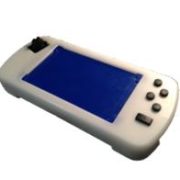Biometrics is of one the world’s most important emerging technologies. They are used to accurately identify criminals, disburse benefits, manage events, protect financial transactions, authorize access, and fight fraud. If you are considering buying a biometric device, here are a few questions that you need to ask.
1) Do you need to read this article? Most biometric transactions are described as verifications, i.e. are you who you say you are? An example would be laptops and smartphones that have a fingerprint sensor that identifies authorized users. Verification can be performed by relativity simple technologies. A much more challenging application is enrollment, in which biometric information from an individual is captured and stored. Purchasing and deploying an enrollment device involves a very complex evaluative process, poses numerous risks, and may incur unforeseen expenses. If you are looking for a mobile enrollment device, this article is for you.
2) Do you need an enrollment device that is mobile? Mobile biometric devices save time, money, and hassle. Consider the following three scenarios:
• Forward-based soldiers enrolling the inhabitants of a village.
• Policemen enrolling a suspect in the field.
• Event managers enrolling clients at an entertainment/sports venue.
In each of the above examples, mobile frees the workers from the chore of ferrying the enrollees back to a base/station/office to use a stationary biometric device. For most applications, the mobility of an enrollment device is an enormous advantage.
In spite of the benefits, many project managers discard the possibility of a mobile biometric device that has enrollment capabilities, because they believe the technological difficulties are too great or costly. This is unfortunate because economic, practical solutions are available.
3) What modality do you want? Biometric modalities include fingerprint, palm veins, facial recognition, DNA, palm print, iris recognition, retina and odor/scent.
By far and away, the most established, popular, and practical modality is fingerprinting. Fingerprints have the largest, most complete databases available, which is an enormous advantage for the purposes of identification. However, fingerprints have their problems. The fingerprints of the elderly and farm workers have been known to become so worn that they are unusable. This is one reason that it is strongly recommended that your biometric device is multimodal. In addition, using more than one modality reduces the problems of noisy data, “spoofing”(fraud), and unacceptable error rates.
Iris and facial recognition are popular complementary modalities to fingerprinting, but you need to evaluate the specific needs of your application. For example, police like cameras, so they can take pictures of gang tattoos. If you are deploying a biometric device for financial applications in Japan, palm vein, which is popular there, would warrant serious consideration.
4) Do I need a device with multiple fingerprint enrollment capability? Experts strongly recommended enrolling more than one finger. Minor injuries and temporary disabilities can compromise the usability of captured images of a single finger.
5) Do you need access to large databases? This really depends on your application. For example, I use a fingerprint sensor to obtain access to my gym. I assume that my gym doesn’t care about interacting with larger databases that local and national governments use to track criminals. They only want to compare my fingerprints with their client list. However, police departments, FBI, and the Department of Homeland Security need to exchange data with other government databases.
Keep in mind special requirements for specific applications. For example, police departments may need compliance with FirstNet standards. Military applications may need special encryption capabilities. More than one buyer has had to replace their entire line of recently purchased biometric devices because they did not meet the requirements for interaction with large databases.
6) What are the requirements for accesses to national and local databases? The most commonly used national database, the Integrated Automated Fingerprint Information System (IAFIS), has very strict standards for the Electronic Fingerprint Templates (EFT) that it accepts. Standards include FAP-45 (Appendix F) and PIV. FAP-45 is the stricter “high-throughput” standard; it is the one that is most likely to affect busy institutional use.
7) How important is the quality of the fingerprint images that my device captures? Very. National Institute of Standards and Technology (NIST) research revealed that image quality directly impacts identification match accuracy. By deploying the highest quality sensors on the most reliable platforms, you can reduce missed identifications/verifications of a subject, additional secondary workload processes, and overall examiner workloads.
8) What kind of fingerprint sensor should I look for? Get a device with a Light Emitting Sensor (LES) sensor. LES multilayer, polymer composite film resists abrasion, operates at extreme temperatures, and isn’t affected by fog or condensation. Unlike traditional optical sensors, direct and bright sunlight do not diminish its ability to capture high quality fingerprint images. Compared to old-fashion systems, the LES sensor is less sensitive to oils left behind from previous users; other sensors need to be cleaned after each capture.
9) What kind of mobile platform should I look for? Get a rugged device; preferably one with a high IP rating and has met military environmental standards, such as MIL-STD 810. You will spend more on the initial cost, but will save in the long run on repair, lost data, downtime, and lost work hours. Public safety officers, relief workers, and warfighters work in harsh environments. They need devices that can get dirty, get wet, take a beating, and still successfully operate.
If you can answer the above questions, you are ready to get started in your search for a mobile enrollment device. Of course, there are many other factors to be considered. If you have any questions, feel free to contact one of AMREL Application Engineers at (800) 8826735.
For over 30 years, AMREL has been a leader in developing highly reliable, fully rugged mobile solutions that operate in the most demanding environments. We supply more than multi-modal handhelds for collection, enrollment, and identification; we provide a generation of expertise. We customize even low-volume orders to craft solutions that are perfect for your needs. See our complete line of biometric devices here.









